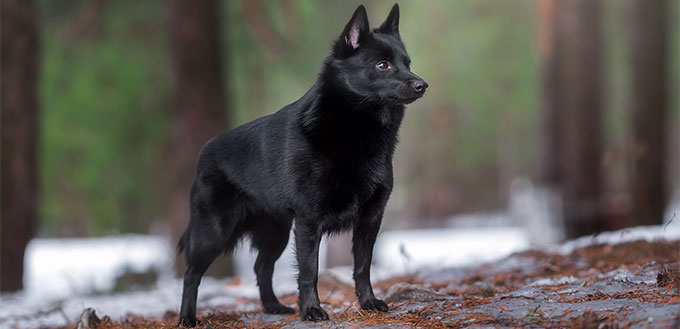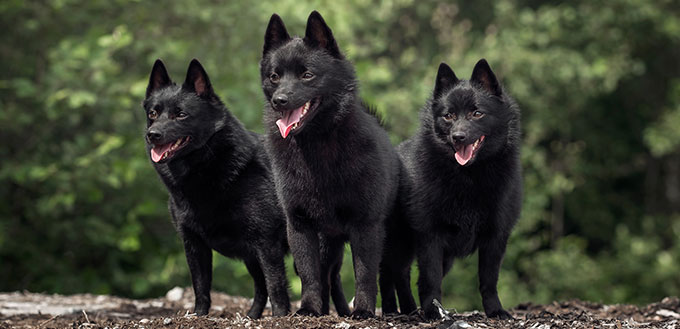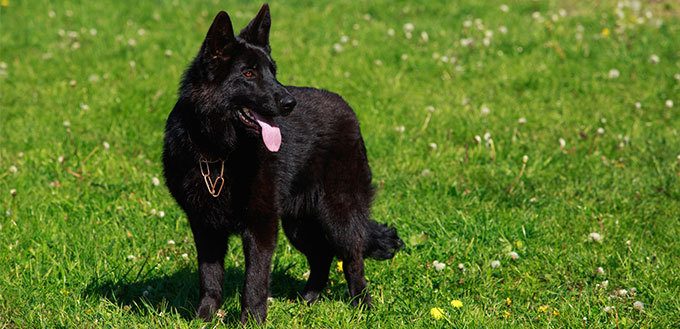The Schipperke dog breed appears to be on the small side but is agile, active, and full of energy in the actual sense of the words. The ball of fun is always curious and adventurous but you need to watch out for this one as it cannot be trusted and can be mischievous sometimes. One advantage of having a Schipperke dog breed, however, is that it is very protective of the home territory and doesn’t take the presence of strangers lightly. Perhaps, this is why the Schipperke is prone to barking as every little noise spooks him.
The foxy-looking dog is a perfect watchdog, a task it was originally created for and does it so well. The breed has been around since medieval times but many don’t know a lot about them. We go down memory lane to explore the facts about this small dog with a big personality.

History of the Schipperke Breed
Mainly pronounced SHEEP-er-ker, though some of the American owners use SKIP-er-kee, this breed’s origin can be traced back to medieval Belgium. It’s a small Belgian dog that was first recognized as a breed in the 1880s. The Schipperkes have spawned many informal debates about their type. While some call them a spitz (because of similar features with the breed, including pointed ears), others say they are miniature sheepdog, notwithstanding, in their birth country Belgium, they are referred to as small shepherd.
The Schipperke is believed to share ancestors with the Belgian sheepdog, also known as the Groenendael. The two dog breeds are presumed to be descendants of a black sheepdog known as a Leauvenaar. What’s more, the Groenendael was created to be a herding breed while the Schipperke breed was brought forth to act as a small watchdog and they have so far exceeded expectations.
Additionally, the dog worked as a shipboard exterminator and watchdog in many places, including ships, barges, homes and shops, keeping the rat population in check. Its fast and agile ways led sailors and shopkeepers to name it schipperke, which is Flemish for “little captain.” Before earning the official name that is still in use to date, the Schipperke was informally known as Spits or Spitzke, a common name given to small dogs with pointed ears. The current name was bestowed on the dog upon the formation of the breed club in 1888.
True to their history, the Schipperkes are still known to love staying around boats and water, even though a lot of things have changed over the centuries since they came into the world. While they started off as watchdogs, after a Schipperke was spotted by Queen Marie Henriette of Austria at a Brussels dog show in 1885, the Schipperke personality took another turn. They subsequently became fashionable pets as the queen was smitten with the one she saw. Consequently, the Schipperke gained popularity in the world and soon, it was launched in the United States in 1888. The inaugural speciality club for the Schipperke in the States was birthed in 1905 but the national club representing the breed – the Schipperke Club of America was founded in 1929.
Today, the Schipperke is still getting a lot of love from pet lovers, especially for their cleverness, loyalty, and a sharp sense of humor. There is literally no dull moment around the furry fellow.
Quick Facts About the Schipperke
- Born to chase is a quick description of the Schipperke personality. The dog breed is always on the move, getting his nose in everybody’s business and chasing smaller animals randomly. For this reason, it’s not safe to keep him around smaller pets or leave the breed unsupervised.
- The Schipperke is, no doubt, one of the smartest dog breeds that are still in existence. This feature sets it aside as an independent pet, often mischievous and very curious as well.
- They are often rebellious and can decide to disobey their owner by doing what pleases them instead of obeying a command. Overall, they are good dogs but probably not the best choice if it’s your first time owning a dog.
- In pop culture, a Schipperke featured in the movie Two Brothers (2004) but not on a regular appearance. Another movie the breed can be seen in is Daphne Du Maurier’s short story “A Borderline Case.”
- This little dog takes the 82nd spot among the 155 breeds and varieties recognized by the American Kennel Club.
- The Schipperke has earned a lot of names over the years, including the “little black fox”, the “Tasmanian black devil”, as well as the “little black devil”.
- Their curious nature and hyperactivity often means they require a good amount of exercise. Their owners should always keep an eye on them, especially when they are on the loose.
- One of the perks of owning this breed is its sense of loyalty and responsibility. The Schipperke guards and protects with all the strength it can muster. The owner of the Schipperke dog breed might feel safe knowing that his dog is always at alert.
- While this breed can have tongues that are completely black, some have varying degrees of pink tongues and patches on the tongue,
- Schipperkes have double coats. The undercoat is soft, fluffy and covered by a stronger and longer outer coat. The breed has a unique long ruff that surrounds the neck, as well as mark a strip trail down the back.
- Their watchdog tendencies often turn them into barkers, unless they are trained to curtail it.
- The dog breed likes to run loose and is happy in a large compound. However, keep them on a leash if the compound is not fenced.
- Though they are mostly seen in black coats, a brown Schipperke is not unlikely. There is also a blue Schipperke, as well as those with blonde coats.

Things You Should Know About the Schipperke
Training
The Schipperke temperament has a lot to do with the way they are trained. Naturally stubborn, smart and independent, this dog breed might change your mind about owning a dog if you don’t give them proper training. For what it’s worth, starting the training process when your Schipperke dog breed is still a puppy makes a lot of difference. If they start socializing with other puppies at this stage, there is a good chance it will be easier to train them.
Because the Schipperke personality sets it aside as a stubborn breed, training might require the services of a professional dog trainer. Crate training is also recommended for better results. Also, to retain this breed’s interest during training, it is necessary to make the process fun and reward good behavior with tasty treats. Even though training a Schipperke is a challenge, when you succeed, they can be good at almost everything.
Related Post: Dog Treats
Altogether, taking your Schipperke to obedience classes is very necessary to guarantee they come when called, starting from their puppy days.
Feeding
The quantity of food you give your dog should depend on factors like size, metabolism rate, activeness of the dog and age. For Schipperkes, they love eating as much as they love barking and getting in everybody’s way. Thus, it is important to give them the right quantity of food to avoid obesity or even diabetes. Apparently, dogs have the same issues humans struggle with everyday and because Schipperkes are small in nature, excessive feeding can really cause a lot of harm to them.
A Schipperke puppy can eat at least three or four meals in a day but when they become adults, the rations will have to reduce. For adults, two meals a day is the recommended pattern but don’t forget to use a measuring cup or scale to get the correct quantity. If you fail to measure your dog’s food or perhaps, you leave the food in the open for them to eat all day, you will soon have an overweight dog with chances of diabetes. Schipperkes are small and should be fed accordingly and if you are not sure of the right food that will meet their nutritional needs, confirm from an expert. For a wider selection of choices, check out our diabetic dog food guide.
Grooming
The chances of a Schipperke shedding hair all year round is not high but they do shed like other dogs. They are double-coated with an undercoat that is soft and fluffy while the outer coat has a harsher-feeling but very unique. The unique coat of the Schipperke is made up of short, medium and long hair on different parts of the body but this doesn’t mean grooming the breed will be hard. On the contrary, grooming a Schipperke is very simple as it only requires weekly brushing to keep the fur away from the floor of your house. However, the breed goes through the blowing coat period when they shed heavily, once or twice a year. At this time, regular grooming becomes necessary to curtail the shedding but nothing a warm bath and the right brush that extends to the undercoat won’t solve. The bath will get the dead hair to loosen up for easy removal. The Schipperke shedding process takes about a month to complete.
Related Post: Dog Shedding Brush
While regular bathing is not really necessary in grooming a Schipperke, brushing of the dog’s teeth at least two or three times a week is recommended. This will help remove tartar and any harmful bacteria. If you can, brush the teeth on a daily basis.
Related Post: Dog Toothbrushes
At least once or twice a month, trim the nails of your Schipperke to keep him comfortable at all times. When the nails start making a clicking sound on the floor, know that they have grown too long. Keeping the nails of your dog trimmed at all times does not just benefit the pet but the next time it jumps up to greet you, scars from scratches won’t be a problem.
As often advised, start brushing a Schipperke’s teeth from puppy days to make it accustomed to the exercise. Also, rewards during grooming will help to keep them in their best behavior when it’s time for a bath or any other grooming exercise.
Health
This dog breed is mostly healthy during their lifetime which spans about 13 to 15 years or more which is not surprising, considering the amount of exercise they get. But, that doesn’t mean they can’t suffer health challenges like other dogs. As a naturally active dog, staying idle and without exercise can pose a health hazard. Again, considering the small size they come in, overfeeding can cause a Schipperke more harm than good. If the Schipperke is not active enough and eats too much, it can develop problems in the bone, heart, teeth or digestive system.
Legg-Perthes and Luxating patella seem to be the common orthopedic problems the breed has. Epilepsy may also occur but this condition seem to be genetically transmitted. One health challenge that should be taken seriously when raising a Schipperke is MPS IIIB. The condition is a genetic mutation that affects about 15% of the Schipperke dog breed and no other breed has been affected thus far. The first signs become noticeable from two to four years of age. It affects balance and makes it difficult for the dog to negotiate obstacles when on the move. For an active dog like the Schipperke, MPS IIIB is a real showstopper.
To keep your Schipperke healthy, health tests like patella evaluation, ophthalmologist evaluation and thyroid evaluation are recommended during visits to the vet.

Temperament
Confident, alert, curious and very responsive define the Schipperke personality. The dog does not give up on any challenge easily and retains the troublesome nature of a puppy for up to 4 to 5 years of age. The stubborn nature of the Schipperke makes it difficult to socialize with people it is not familiar with but with its own people, it is always ready to please. However, it often likes to have its own way.
Training a Schipperke is no walk in the park because of its mischievous and stubborn personality. Nevertheless, the Schipperke temperament can be calmed through socialization from a young age and positive reinforcement during training. Basically, the Schipperke personality and temperament depend on how and where you raise them.
Sources:
- Schipperke, PetMD
- Schipperke, VetStreet







